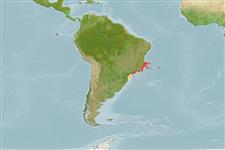Klassifizierung / Names
Namen | Synonyme | Catalog of Fishes(Gattung, Arten) | ITIS | CoL | WoRMS | Cloffa
>
Eupercaria/misc (Various families in series Eupercaria) >
Scaridae (Parrotfishes) > Sparisomatinae
Etymology: Sparisoma: Latin, sparus = a fish with a golden head + Greek, soma = body (Ref. 45335); tuiupiranga: From the Tupi for 'red parakeet', the native American language once spoken along the Brazilian coast, and refers to the splendid color of initial phase adults of this small parrotfish.
Environment: milieu / climate zone / depth range / distribution range
Ökologie
seewasser riff-verbunden; tiefenbereich 5 - 20 m (Ref. 52151). Subtropical; 17°S - 28°S
Southwestern Atlantic: from the state of Bahia (Abrolhos Archipelago National Marine Park to the state of Santa Catarina), Brazil.
Size / Gewicht / Alter
Maturity: Lm ? range ? - ? cm
Max length : 15.4 cm SL Männchen/unbestimmt; (Ref. 52151)
Found in shallow areas of tropical rocky reefs. Males establish territories (approximately 8 m2). Juveniles are strongly associated with seaweed beds, occasionally found mixed with Sparisoma radians and Cryptotomus roseus. This species is typically a scraper which grazes upon a large variety of epilithic algae (e.g. Jania, Gelidium, Polysiphonia, consequently ingesting a large quantity of sediment. It is however, very plastic in its feeding habits and is commonly observed browsing over Sargassum. Males and larger initial phase adult individuals perform up to 2400 bites daily with a mean gut turnover of about 2.5 guts day-1, having an important role on local energy flux (Ref. 52151).
Life cycle and mating behavior
Geschlechtsreife | Fortpflanzung | Ablaichen | Eier | Fecundity | Larven
Gasparini, J.L., J.-C. Joyeux and S.R. Floeter, 2003. Sparisoma tuiupiranga, a new species of parrotfish (Perciformes: Labroidei: Scaridae) from Brazil, with comments on the evolution of the genus. Zootaxa 384:1-14. (Ref. 52151)
IUCN Rote Liste Status (Ref. 130435: Version 2024-2)
Bedrohung für Menschen
Harmless
Nutzung durch Menschen
Tools
Zusatzinformationen
Download XML
Internet Quellen
Estimates based on models
Preferred temperature (Ref.
123201): 23.4 - 26.4, mean 25.8 °C (based on 67 cells).
Phylogenetic diversity index (Ref.
82804): PD
50 = 0.5000 [Uniqueness, from 0.5 = low to 2.0 = high].
Bayesian length-weight: a=0.01622 (0.00965 - 0.02725), b=3.13 (2.98 - 3.28), in cm total length, based on LWR estimates for this species & Genus-body shape (Ref.
93245).
Trophic level (Ref.
69278): 2.0 ±0.00 se; based on food items.
Widerstandsfähigkeit (Ref.
120179): hoch, Verdopplung der Population dauert weniger als 15 Monate. (Preliminary K or Fecundity.).
Fishing Vulnerability (Ref.
59153): Low vulnerability (10 of 100).
